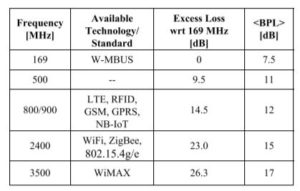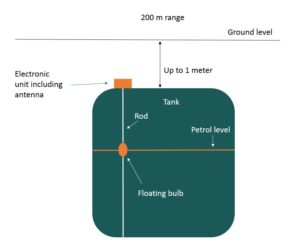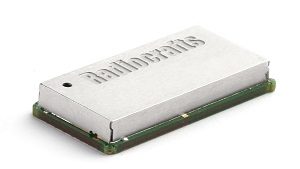The sudden and seemingly endless increase in the urbanization process currently taking the world by storm is raising problems and concerns about the perceived quality of life in urban environments. Smart and effective solutions must be conceived and deployed in order to tackle the many issues related to public and private safety, healthcare, supplying of goods and resources, as well as their management and distribution. These types of solutions, now more than ever, commonly rely on strong technological support made up of sensors and devices spread throughout an urban layout. These sensors and devices combined with their corresponding management, control communication networks, and the related applications and services are used for improved urban sustainability and efficiency. This city environment, which is made smarter via embedded technological infrastructures is what is referred to as a “Smart City”. Many applications exist in Smart Cities where the sensors and devices are often placed in hard-to-reach places, such as, in smart metering, where these meters are often stored in basements or in metal cabinets where propagation conditions are poor. In such cases, a 169 MHz solution is most optimal, and we will uncover why in this blog post.
Therefore, in this blog post we are going to discuss the different features which make the 169 MHz band ideal for sensors and devices in hard-to-reach places, then we will provide some examples of recent existing use cases for Radiocrafts’ 169 MHz modules. Finally, we will present the various benefits of designing a device/sensor with a Radiocrafts’ 169 MHz solution, as we are pioneers in the development and standardization of the 169 MHz band.
Benefits of the 169 MHz ISM Band
As mentioned previously, the 169 MHz ISM band is ideal for sensors/devices which are located in hard-to-reach places. Why? This is because the 169 MHz band allows for good RF performance in terms of building penetration, coverage, and consumption of battery.
 The table to your right shows the free space excess loss for different frequencies with respect to 169 MHz, together with the related mean value of the Building Penetration Loss. As you can see, the increasing propagation loss with increasing frequencies impacts coverage and network performance. Additionally, this effect would be even stronger if we measured the propagation in a real environment instead of in an ideal free space condition. Many experts have done experiments in this field which have been picked up by various different authors and are illustrated in this IEEE document[1].
The table to your right shows the free space excess loss for different frequencies with respect to 169 MHz, together with the related mean value of the Building Penetration Loss. As you can see, the increasing propagation loss with increasing frequencies impacts coverage and network performance. Additionally, this effect would be even stronger if we measured the propagation in a real environment instead of in an ideal free space condition. Many experts have done experiments in this field which have been picked up by various different authors and are illustrated in this IEEE document[1].
Additionally, the physical properties of the lower operating frequency ensure the radio waves travel further, and have better penetration in buildings and “hard-to-reach” places. As a rule of thumb, a long wavelength, which is a physical property of a lower frequency, will penetrate objects best whereas a shorter wavelength (higher frequency) will slip through openings best.
The relatively low frequency combined with high transmission power (up to 500 mW) of the 169 MHz band, enables radio communication at long range. In addition, narrow band radio (12.5 or 25 kHz) is used to get the best radio receiver sensitivity. A communication range of 3-4 km in urban environment has been demonstrated using ultra-narrowband radio modules at 169 MHz (see Radiocrafts Application Note AN021).
Another main benefit of 169 MHz based radio is the simplicity and reliability of the point-to-point network, and hence reduction of operational cost. The devices operating in the 169 MHz band do not require any repeaters. The drawback of technologies using repeaters or mesh technology is the installation and maintenance of such repeaters, and the higher power consumption of mesh networking devices. Gas and water meters do not have access to mains power and must run off batteries. This prevents the meters to act as a router in a mesh network. Establishing dedicated routers or repeaters is complicated with respect to getting access to installation sites and access to mains power at these sites, as well as the maintenance of such devices. Additionally, the 169 MHz band is a less congested than the more popular higher frequency band which improves reliability significantly. Now that we understand the benefits of the 169 MHz band, what are a few use cases?
To learn more about the 169 MHz frequency band, please read our white paper 011 here.
Radiocrafts’ 169 MHz Module Use Cases
Radiocrafts has tens of hundreds of 169 MHz modules deployed in the field to date. The applications range from Smart Metering applications to Smart City applications. Two interesting, recent, and demonstrative applications using Radiocrafts 169 MHz modules show you how truly impressive the penetration and range properties of the 169 MHz band really are.
 The first application is a tank level measurement device for buried petrol tanks designed by Alisonic. It includes a tuned helical antenna that operates in the 169 MHz frequency band and works with an embedded Radiocrafts’ RC1701HP-MBUS4 module. The intelligence in the system is located inside an electronic unit on top of a petrol tank. A rod which is placed inside the tank is connected to the electronic unit. Sliding on the rod is a floating bulb which will float at the same level as the petrol inside the tank. The system measures the distance from the electronic unit to where the floating bulb sits with millimeter precision allowing you to know exactly how much petrol is left inside the tank. The petrol tank is located up to one-meter underground which is a major reason why the choice was made to use the 169 MHz band. The 169 MHz operation and the use of the RC1701HP-MBUS4 allows for an impressive range of up to 200 meters over ground despite the fact that the antenna is located up to a meter underground. To read more about the Alisonic tank measurement device, please click here.
The first application is a tank level measurement device for buried petrol tanks designed by Alisonic. It includes a tuned helical antenna that operates in the 169 MHz frequency band and works with an embedded Radiocrafts’ RC1701HP-MBUS4 module. The intelligence in the system is located inside an electronic unit on top of a petrol tank. A rod which is placed inside the tank is connected to the electronic unit. Sliding on the rod is a floating bulb which will float at the same level as the petrol inside the tank. The system measures the distance from the electronic unit to where the floating bulb sits with millimeter precision allowing you to know exactly how much petrol is left inside the tank. The petrol tank is located up to one-meter underground which is a major reason why the choice was made to use the 169 MHz band. The 169 MHz operation and the use of the RC1701HP-MBUS4 allows for an impressive range of up to 200 meters over ground despite the fact that the antenna is located up to a meter underground. To read more about the Alisonic tank measurement device, please click here.
 The second application is a device designed by the University of Cardiff known as a Cryoegg, which was designed to help scientists understand how glaciers are moving and sliding towards the ocean. The device reports on the behavior of the meltwater located underneath or deep within the glaciers. The Cryoegg measures water temperature, pressure (measures structural organization of the water under the ice sheets), and conductivity (measures how long meltwater has been residing in a specific location) at the base of the ice sheet. The radio system being used for this device is the Radiocrafts RC1701HP-MBUS4 module which operates in the 169 MHz band.
The second application is a device designed by the University of Cardiff known as a Cryoegg, which was designed to help scientists understand how glaciers are moving and sliding towards the ocean. The device reports on the behavior of the meltwater located underneath or deep within the glaciers. The Cryoegg measures water temperature, pressure (measures structural organization of the water under the ice sheets), and conductivity (measures how long meltwater has been residing in a specific location) at the base of the ice sheet. The radio system being used for this device is the Radiocrafts RC1701HP-MBUS4 module which operates in the 169 MHz band.
The University of Cardiff has recently conducted field work using the Cryoegg on various different glaciers located in Greenland and Switzerland. They performed a surface level range test at Store Glacier in west Greenland and got a range in excess of 1.6km. We mention “in excess” because the terrain became too difficult to continue. Inside the deep borehole at East Greenland Ice Core Project (EGRIP), a signal as far as 1.35km below the glacier was calculated. The Cryoegg was also tested in moulins (sinkholes in glaciers) at the RESPONDER site located at the Store Glacier in West Greenland and Rhone Glacier located in the Swiss Alps. The live readout from the Cryoegg proved to be very helpful in detecting plunge pools and for salt tracing streams and moulins. These two and many more interesting projects have been designed using Radiocrafts 169 MHz solutions. So why Radiocrafts?
To read more about the Cryoegg and the Glacier Expedition, click here.
Radiocrafts’ Involvement In The Standardization Process of 169 MHz Radio Solutions
Radiocrafts has been a pioneer in the standardization and development of radio solutions in the 169 MHz band with several thousand modules already deployed.
Radiocrafts has been an active member of the CEN TC294 standardizing the use of 169 MHz in Europe for many years. This group works in the standardization of communication interfaces for systems with meters and remote reading of meters for all kind of fluids and energies distributed by network. The use of 169 MHz for metering applications was first standardized in the EN 13757-4:2013. The new N mode defined 6 channels in the VHF band, and combined low bandwidth (12.5 kHz) and high transmission power (500 mW) to achieve a superior radio performance. The 169 MHz band is not limited to metering applications, but also other types of sensors can take benefit from this technology. Industrial wireless sensor networks can use this technology to improve the robustness and reliability of the radio link.
Radiocrafts can also assist in design of 169 MHz equipment, we have a long experience in antenna and power management designs needed for a successful design project. Read our application note on tuning a 169 MHz antenna here.
Radiocrafts already provides a range of products based on Wireless M-Bus at 169 MHz
- RC1701HP—MBUS4, the module which supports the N-mode
- RC1701HP-MPC1, the module with pulse counter, tamper, and install inputs
- RC1701HP-MSM, the sensor interface module with integrated sensor interfaces.
- RC1701HP-WIZE, a novel approach to a wireless LPWAN network for Industrial IoT applications based on Wireless M-Bus at 169 MHz.
The RC1701HP-WIZE is especially interesting because it is the very first Wize-compliant module being released by the Wize Alliance. But what is the Wize Alliance?
Wize Alliance:
The Wize Alliance is a non-profit company from France who are promoting an international standard for the Industrial Internet of Things. It brings together major international players from the from the industrial and utility sectors in order to support the implementation of the LPWAN technology called WIZE. WIZE was specifically designed to connect to hard to reach objects, leveraging over ten years of filed deployments, WIZE delivers secure information for Internet of Things applications for cities and industries. Today, networks using WIZE technology connect over 3 million objects worldwide and continue to expand.
Radiocrafts joined the Wize Alliance as one of the first members and is now part of a growing, 40+ member association. Radiocrafts is also preparing the launch the first ever module with WIZE Protocol, the RC1701HP-WIZE.
The Wize protocol is a long range, low power, and bi-directional radio communication that operates in the 169 MHz frequency. It is a result of the development of a new LPWAN solution based on Wireless M-Bus mode N at 169 MHz. Wize was specifically designed to connect hard-to-reach objects and to ensure deployments on a territory-wide scale for the city’s uses, which require integration in a constrained environment: metering, public lighting, energy management of builds and etc. The technology was first developed for gas and water metering in France, but now, this technology is being made available for a wider market outside of France and is no longer limited to smart metering. Smart city and Industrial IoT applications are now available for Wize such as waste management.
The Wize protocol provides:
- A proven solution based on the Wireless M-Bus standard
- ower efficient 2-way communication protocol for sensor reading and control
- Robust communication and wide area coverage
- Secure transfer of data in terms of privacy, data integrity, and authentication
- 15 + years of battery operation
- Firmware over-the-air updates
Additionally, on a territory-wide scale, deployment of the network is simple and fast because the technology requires little equipment (a communicating object and a concentrator). No repeater system, no pairing or complex programming sensors are required.
Furthermore, since the device has a battery lifetime of up to 20 years and a minimum amount of equipment needed in the system, this proves to be a low maintenance technology, helping you save money.
To read more about the Wize alliance please visit their website here.
To read more about the Wize protocol please read our white paper number 016 here, or, visit our Wize product page here.
To read about the differences between Wize and Wireless M-Bus, click here.
What To Take Away From This?
The world is becoming more city-centric as masses of people are continuously choosing the city-lifestyle over the rural-lifestyle. We need to adapt to these shifts in living conditions through the evolution of technology. In this blog post, we have often times seen these new technologies such as sensors, and other general IoT devices be located in hard-to-reach places with poor signal propagation. In these cases, the 169 MHz ISM band is optimal. The low data rates in a narrowband radio channel, together with the relative low operating frequency (169 MHz) and high transmission power, is the fundamental key to the long range and great penetration properties that can be achieved in this band. Even several kilometre range in urban areas, with deep penetration into buildings and other “hard to reach” places. There are several associations and groups around the world such as Wize Alliance and CEN TC294 who are on a quest to develop sustainable solutions for the 169 MHz frequency band. Radiocrafts is a part of both of these groups and as a result of this, have several products which support the 169 MHz frequency band, including the new Wize Protocol which will take the world by storm.







